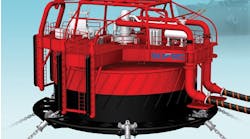Technology-agnostic approach, holistic infrastructure needed for future ROC workstations
By Kristoffer Sortland, Remota
Uncrewed surface vessels (USVs) are making their way into the offshore industries. With the promise of reducing the emissions from subsea operations with about 90% compared to traditional large multi-purpose vessels, USVs are a great example of how digital tools and remote operations can reduce the energy consumptions from the offshore energy industries.
In Norway, different concepts for USVs are now being introduced with slightly different operational patterns, technologies and approaches. Different projects being introduced in the market drives innovation in the industry and leads to technological advancements in remote operations.
Alongside the technological innovations in USVs, there is a need for continuous developments in remote operation center (ROC) infrastructure meeting the needs of the ROC operators. This calls for both user-centric design, and a focus on developing attractive and inclusive work environments.
The USV Challenger project comprises a 24-m USV with an onboard work-class ROV serving energy infrastructure in the North Sea area. This includes co-locating both the vessel operation functions and the operation of the ROV in the same ROC control room at Remota. By co-location of operation stations for all vessel functions, a shared understanding of vessel and operation status is created, in addition to an environment of engaging collaboration for ROC operators.
At this stage of development within remote operation and monitoring of USVs, the ROC workstations and integrated technologies are to some extent based on proprietary infrastructure supplied by the technology vendors and system integrators for the vessel. This is also the case for the control room infrastructure for the USV Challenger and is in many ways due to the status of development and experience in the industry. Consequently, this makes future integration and collaboration across different vessel systems challenging and conflicts with the ambitions of fully flexible remote operation platforms for USVs.
Despite this proprietary nature of the USV infrastructure, there is a considerable amount of built-in flexibility within the system, making the remote operation platform for the USV Challenger project adaptable and future-ready for Remota's vision of holistic ROC workstations. In this vision, flexibility, scalability and multi-disciplinarity are central elements for both technology and the operations themselves, making multi-USV operations available from the same control room infrastructure.
For the future of ROC workstations, a technology-agnostic approach, with holistic and generic ROC infrastructure being able to integrate with any technology vendor and system integrator should be pursued. Not only will this encourage innovation within ROC technologies, but it will also provide strengthened opportunities for cross-discipline collaboration among ROC operators. In the long run, Remota believes new ROC operator roles may even be developed where resources are shared between different functions, operations and projects, enabling an even higher level of agility and flexibility in remote operations. Getting there will to some extent require a higher level of collaboration and trust in the industry. But in turn, easier integration across different technology vendors and open innovation will be enabled.





